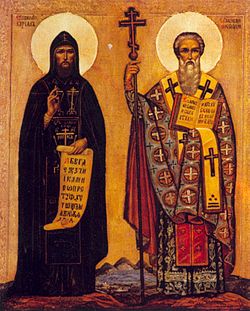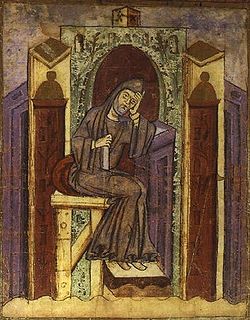Top Qs
Timeline
Chat
Perspective
April 6 (Eastern Orthodox liturgics)
From Wikipedia, the free encyclopedia
Remove ads
April 5 — Eastern Orthodox liturgical calendar — April 7

All fixed commemorations below are observed on April 19 by Orthodox Churches on the Old Calendar.[note 1]
For April 6th, Orthodox Churches on the Old Calendar commemorate the Saints listed on March 24.
Saints
- Hieromartyr Archilias, Priest, and Martyr Jeremiah, of Rome (3rd century)[1][2][3]
- Venerable Platonis (Platonida) of Nisibis, reposed in peace (c. 300-308)[1][4][5]
- Martyr Platonis (Platonides) and two martyrs buried up to their loins,[3] at Ascalon in Palestine.[6][7]
- Hieromartyr Irenaeus, Bishop of Sirmium in Hungary (304)[8] (See also: March 26 - Church of Romania)
- 120 Martyrs of Persia under Shapur II (c. 344-347)[1][7][9][10]
- Martyrs Timothy and Diogenes, in Macedonia, by Arians (345)[7][11]
- Saint Eutychius, Patriarch of Constantinople (582)[1][12][13]
- Equal-to-the-Apostles Methodius of Moravia, Archbishop of Moravia and Enlightener of the Slavs (885)[1][14] (see also: May 11)
Remove ads
Pre-Schism Western saints
- Saints Florentius, Geminianus and Saturus, martyrs in Sirmium in Pannonia (4th century)[15]
- Saints Rufina, Moderata, Romana, Secundus and Seven Companions, martyred at Sirmium in Pannonia (4th century)[15]
- Saint Marcellinus of Carthage, imperial representative in North Africa, martyred by the Donatists (413)[15][16]
- Saint Celestine, Pope of Rome (432)[7][15][17][18][note 2]
- Saint Brychan, a King in Wales with twenty-four saintly children (5th century)[15]
- Saint Ulched (Ulchad, Ylched), a holy man who gave his name to Llechulched in Anglesey in Wales.[15]
- Saint Winebald (Winewald, Vinebaud), a monk at Saint-Loup-de-Troyes in France where he became abbot (c. 650)[15]
- Saint Derfel (Tervillius) the Prince, son of King Joel II, became a hermit in Llandderfel in Gwynedd in Wales (660)[19] (see also: April 5)
- Saint Gennard, a monk at Fontenelle Abbey in France and eventually Abbot of Flay (Saint-Germer-de-Fly Abbey) (720)[15]
- Saint Berthanc (Berchan), a monk at Iona in Scotland and later Bishop of Kirkwall in Orkney (c. 840)[15][20][note 3]
- Saint Prudentius of Troyes (Prudentius Galindo) (861)[15][note 4]
- Saint Notker the Stammerer, nicknamed Balbulus (the Stammerer), monk at St Gall Abbey where he spent his whole life, excelling as a musician (912)[15][21]
- Saint Urban, Abbot of the Monastery of Peñalba near Astorga in Spain (c. 940)[15]
- Saint Ælfstan (Elstan), monk who became Bishop of Ramsbury and succeeded St Ethelwold as Abbot of Abingdon (981)[15][22]
Remove ads
Post-Schism Orthodox saints
- Venerable Gregory (Drimys) of the Great Lavra on Mount Athos (Gregory the Byzantine) (1310), instructor of St. Gregory Palamas.[1][23][24]
- Venerable Gregory of Sinai (Mt. Athos) (Gregory the Sinaite) (1347)[1][25]
- Venerable Rufus the Obedient, of the Kiev Far Caves (14th century)[26] (see also: April 8)
- New Martyr Nicholas the Deacon, of Mytilene (1463)[1][note 5]
- Saint Aphonios, Bishop of Novgorod from 1635-1649 (1652)[27][note 6]
- New Martyr Paul the Russian, at Constantinople (1683)[1] (see also: April 3)
- New Hieromartyr Gennadius of Dionysiou, Mt. Athos, at Constantinople (1818)[1][28]
- New Martyrs Manuel, Theodore, George, Michael, and another George, of Samothrace, at Makri in Thrace (1835)[1][29]
- Saint Martyrius, monk of Glinsk Hermitage (1865)[1]
New martyrs and confessors
Other commemorations
- Repose of Hieromonk Arsenius of Valaam Monastery (1853)[1]
- Repose of Elder Mardarius of the Nizhni-Novgorod Caves Monastery (1859)[1]
- Repose of Archimandrite Seraphim (Tyapochkin) of Rakitin (1982)[1][note 8]
Icon gallery
- Sts. Cyril and Methodius (Icon from 18th or 19th century)
- Saint Celestine, Pope of Rome.
- Blessed Notker of Saint Gall.
- Shrine of New Hiero-confessor Sebastian (Fomin).
Notes
- The notation Old Style or (OS) is sometimes used to indicate a date in the Julian Calendar (which is used by churches on the "Old Calendar").
The notation New Style or (NS), indicates a date in the Revised Julian calendar (which is used by churches on the "New Calendar"). - Born in the Campagna in Italy, he succeeded Boniface I as Pope of Rome in 422. He supported St Germanus of Auxerre against Pelagianism and condemned Nestorianism.
- See also: The Prophecy of Berchán.
- Born in Spain, in his youth he fled from the Saracens to France, where he changed his baptismal name Galindo to Prudentius. He became Bishop of Troyes.
- See: (in Russian) Аффоний (митрополит Новгородский). Википедии. (Russian Wikipedia).
- See: (in Russian) Севастиан (Фомин). Википедии. (Russian Wikipedia).
- See: (in Russian) Серафим (Тяпочкин). Википедии. (Russian Wikipedia).
Remove ads
References
Sources
Wikiwand - on
Seamless Wikipedia browsing. On steroids.
Remove ads





